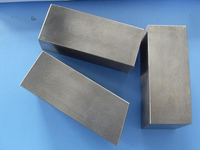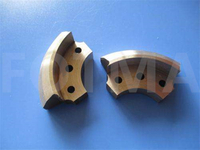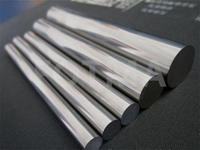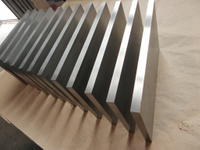Views: 4 Author: Site Editor Publish Time: 2020-06-15 Origin: Site
(1) Sand casting: casting method for producing castings in sand casting. Steel, iron and most non-ferrous alloy castings can be obtained by sand casting. Process flow: sand casting process technical characteristics: 1. Suitable for making blanks with complex shapes, especially with complex inner cavities; 2. Wide adaptability and low cost; 3. For some materials with poor plasticity, such as cast iron Etc., sand casting is the only forming process for manufacturing its parts or blanks. Application: Castings such as engine cylinder block, cylinder head and crankshaft of automobile
(2) Investment casting: usually refers to making a pattern on a fusible material, covering the surface of the pattern with several layers of refractory material to make a shell, and then melting the pattern out of the shell to obtain a mold without a parting surface. Casting scheme that can be filled with sand after roasting at high temperature. Often called "lost wax casting." Process flow: investment casting process flow process characteristics advantages: 1. High dimensional accuracy and geometric accuracy; 2. High surface roughness; 3. Ability to cast complex-shaped castings, and the casting alloy is not limited. Disadvantages: complicated process and high cost Application: suitable for the production of small parts with complex shapes, high precision requirements, or difficult to perform other processing, such as turbine engine blades.
(3) Die casting: It uses high pressure to press the molten metal into the cavity of a precision metal mold at high speed. The molten metal is cooled and solidified under the pressure to form a casting. Process flow: process characteristics and advantages: 1. High pressure on metal liquid during die casting, fast flow rate 2. Good product quality, stable size, good interchangeability; 3. High production efficiency, more use of die casting mold; 4. Suitable for large quantities Production and good economic benefits. Disadvantages: 1. Castings are prone to produce small pores and shrinkage. 2. The plasticity of the die-casting parts is low, and it is not suitable to work under the impact load and vibration; 3. When the high-melting alloy die-casting, the mold life is low, which affects the expansion of the die-casting production. Applications: Die castings were first used in the automotive industry and instrumentation industry, and then gradually expanded to various industries, such as agricultural machinery, machine tool industry, electronics industry, defense industry, computer, medical equipment, clocks, cameras and daily hardware, etc. .
(4) Low pressure casting: refers to the method of making liquid metal fill the mold under the action of lower pressure (0.02 ~ 0.06MPa), and crystallize under pressure to form a casting. Process flow: technical characteristics: 1. The pressure and speed during pouring can be adjusted, so it can be applied to various different casting molds (such as metal molds, sand molds, etc.), casting various alloys and castings of various sizes; 2. Using bottom Injection type filling, the liquid metal filling is stable, no splash phenomenon, can avoid the gas involved and the scouring of the mold wall and core, improve the casting pass rate; 3, the casting crystallizes under pressure, the casting structure is dense, contour Clear, smooth surface, high mechanical properties, especially for the casting of large thin-walled parts; 4. Eliminate the filler riser, metal utilization rate increased to 90 ~ 98%; 5. Low labor intensity, good working conditions, equipment Simple and easy to realize mechanization and automation. Application: Mainly based on traditional products (cylinder head, hub, cylinder frame, etc.).
(5) Centrifugal casting: It is a casting method in which molten metal is poured into a rotating casting mold, and the casting mold is filled and solidified under the action of centrifugal force. Process flow: process characteristics and advantages: 1. There is almost no metal consumption of the pouring system and the riser system, which improves the production rate of the process; 2. The core can not be used when producing hollow castings, so when producing long tubular castings, it can be greatly Improve the metal filling ability; 3. The casting has high density, less defects such as pores and slag inclusions, and high mechanical properties; 4. It is easy to manufacture tube and sleeve composite metal castings. Disadvantages: 1. There are certain limitations when used in the production of special-shaped castings; 2. The diameter of the inner hole of the casting is inaccurate, the surface of the inner hole is rough, the quality is poor, and the machining allowance is large; 3. The casting is prone to segregation of specific gravity. Application: The centrifugal casting is the earliest used for the production of cast pipes. At home and abroad, the centrifugal casting process is used in the metallurgy, mining, transportation, irrigation and drainage machinery, aviation, national defense, automobile and other industries to produce steel, iron and non-ferrous carbon alloy castings. Among them, the production of castings such as centrifugal cast iron tubes, internal combustion engine cylinder sleeves and shaft sleeves is the most common.
(6) Metal mold casting: refers to a molding method in which liquid metal fills a metal mold under the action of gravity and cools and solidifies in the mold to obtain a casting. Process flow: process characteristics and advantages: 1. The metal mold has large thermal conductivity and heat capacity, fast cooling speed, dense casting structure, and mechanical properties about 15% higher than sand castings. 2. Can obtain castings with higher dimensional accuracy and lower surface roughness value, and good quality stability. 3. Because the sand core is not used and rarely used, it can improve the environment, reduce dust and harmful gases, and reduce labor intensity. Disadvantages: 1. The metal mold itself is not breathable, and certain measures must be taken to extract the air generated in the cavity and the gas generated by the sand core; 2. The metal mold has no concessions, and it is easy to crack when the casting is solidified; 3. The metal mold manufacturing The cycle is longer and the cost is higher. Therefore, it can only show good economic effects when it is produced in large quantities. Application: Metal mold casting is not only suitable for mass production of aluminum alloy, magnesium alloy and other non-ferrous alloy castings with complex shapes, but also suitable for the production of steel metal castings and ingots.
(7) Vacuum die-casting: an advanced die-casting process that eliminates or significantly reduces the porosity and dissolved gas in the die-casting parts by pumping the gas in the die-casting mold cavity during the die-casting process, thereby improving the mechanical properties and surface quality of the die-casting parts. Process flow: process characteristics and advantages: 1. Eliminate or reduce the pores inside the die-casting parts, improve the mechanical properties and surface quality of the die-casting parts, improve the plating performance; 2. Reduce the back pressure of the cavity, you can use a lower specific pressure and For alloys with poor casting performance, it is possible to die-cast larger castings with a small machine; 3. Improve the filling conditions, and can cast thinner castings; Disadvantages: 1. The mold sealing structure is complicated, and it is difficult to manufacture and install, so the cost is relatively high High; 2. If the vacuum die casting method is not properly controlled, the effect is not very significant.
(8) Squeeze casting: It is a method to solidify and flow-form liquid or semi-solid metals under high pressure to directly obtain parts or blanks. It has the advantages of high utilization rate of liquid metal, simplified process and stable quality. It is an energy-saving metal forming technology with potential application prospects. Process flow: direct squeeze casting: spraying paint, pouring alloy, mold clamping, pressurization, holding pressure, pressure relief, mold splitting, blank demoulding, resetting; indirect squeeze casting: spraying paint, mold clamping, feeding, filling Type, pressurization, holding pressure, pressure relief, parting, blank demoulding, reset. Technical features: 1. It can eliminate internal defects such as porosity, shrinkage and shrinkage; 2. Low surface roughness and high dimensional accuracy; 3. Can prevent the occurrence of casting cracks; 4. It is easy to realize mechanization and automation. Application: Can be used to produce various types of alloys, such as aluminum alloy, zinc alloy, copper alloy, ductile iron, etc.
(9) Lost Foam Casting (also known as solid casting): It is a combination of paraffin or foam model similar to the size and shape of the casting to form a model cluster, brushed with refractory coating and dried, then buried in dry quartz sand for vibration modeling , Casting under negative pressure to vaporize the model, liquid metal occupies the model position, a new casting method that forms the casting after solidification and cooling. Technological process: pre-foaming→foaming molding→dipping paint→drying→modeling→pouring→falling sand→cleaning Technical features: 1. High casting precision, no sand core, reducing processing time; 2. No parting surface, Flexible design and high degree of freedom; 3. Clean production and no pollution; 4. Reduce investment and production costs. Application: It is suitable for producing various sizes of more precise castings with complex structure, unlimited alloy types and unlimited production batches. Such as gray cast iron engine box, high manganese steel elbow, etc.
(10) Continuous casting: It is an advanced casting method. Its principle is to continuously pour molten metal into a special metal mold called crystallizer. The solidified (crusted) castings are continuously crystallized from the crystal. The other end of the device is pulled out, and it can obtain castings of any length or specific length. Process flow: technical characteristics: 1. Because the metal is rapidly cooled, the crystal is dense, the structure is uniform, and the mechanical properties are good; 2. The metal is saved and the yield is improved; 3. The process is simplified, and the modeling and other processes are eliminated, thus reducing the Labor intensity; the required production area is also greatly reduced; 4. Continuous casting production is easy to achieve mechanization and automation and improve production efficiency. Application: Continuous casting can be used to cast long castings with constant cross-sectional shape, such as ingots, slabs, bar billets, pipes, etc., such as steel, iron, copper alloy, aluminum alloy, magnesium alloy.





